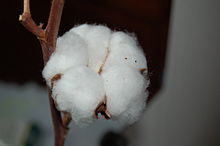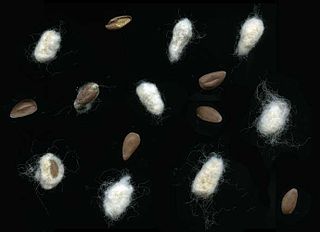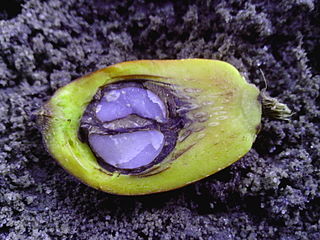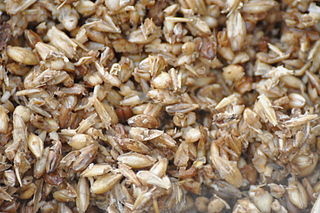

The mature seeds are brown ovoids weighing about a tenth of a gram. By weight, they are 60% cotyledon, 32% coat and 8% embryonic root and shoot. These are 20% protein, 20% oil and 3.5% starch. Fibers grow from the seed coat to form a boll of cotton lint. The boll is a protective fruit and when the plant is grown commercially, it is stripped from the seed by ginning and the lint is then processed into cotton fibre. For unit weight of fibre, about 1.6 units of seeds are produced. The seeds are about 15% of the value of the crop and are pressed to make oil and used as ruminant animal feed. About 5% of the seeds are used for sowing the next crop.
Cottonseed is crushed in the mill after removing lint from the cotton boll. The seed is further crushed to remove any remaining linters or strands of minute cotton fibers. The seeds are further hulled and polished to release the soft and high-protein meat. These hulls of the cottonseed are then mixed with other types of grains to make it suitable for the livestock feed. Cottonseed meal and hulls are one of the most abundantly available natural sources of protein and fiber used to feed livestock. [1]
Cottonseed as supplement is marketed primarily towards agricultural sectors that feed dairy cows. Some feedlots use corn to supplement the forage diets of cows; high starch diets, such as those in corn supplemented diets, can lead to liver damage in cows. [2] Cottonseed is considered a safer alternative to corn supplemented diets due to its low starch content. [3] Cottonseed as livestock feed must also be monitored for safety since the foodstuff is high in energy/fat and too much fat content in a cow's diet can disrupt its ability to digest fiber, leading to other complications. [4]
Cottonseed meal
Cottonseed meal is a good source of protein. The two types of meal extraction processes are solvent extraction and mechanical extraction. Most of the meal is extracted mechanically through cottonseed kernels. The flaked cottonseed kernels are put under high pressure through a screw inside a constantly revolving barrel. The screw pushes out the oil through the openings made in the barrel. The dry pieces left in the barrel are preserved and ground into meal. During the solvent extraction process, the cottonseed kernels are subjected to fine grinding by pushing them through an expander and then the solvent is used to extract most of the oil. The solvent-extracted meals have a lower fat content of 0.5% than the mechanically extracted meals with a fat content of 2.0%. Cottonseed meal contains more arginine than soybean meal. Cottonseed meal can be used in multiple ways: either alone or mixed with other plant and animal protein sources. [5]
Cottonseed hulls
The outer coverings of the cottonseed, known as cottonseed hulls, are removed from the cotton kernels before the oil is extracted. Cottonseed hulls are an excellent source of livestock feed as they contain about 8% cotton linters, which are nearly 100% cellulose. They require no grinding and easily mix with other feed sources. As they are easy to handle, their transportation cost is also fairly low. Whole cottonseed is another feed product of cottonseed used to feed livestock. It is the seed left after the separation of long fibres from cotton, and serves as a good source of cellulose for ruminants. Whole cottonseed leads to high production of milk and fat when fed to a high-producing dairy cow. It can be cost effective and provides nutrients with a high protein value of about 23%, crude fibre value of 25%, and high energy value of 20%. Whole cottonseed serves as a highly digestible feed which also improves the reproductive performance in livestock. Pima cottonseed, which is free of linters by default, and delinted cottonseed are other types of cottonseed feed products. [6]
Cottonseeds are toxic to humans and most animals due to the presence of gossypol, though it is tolerated by cows, and cannot be consumed by humans without processing. In order to make cottonseed oil fit for human consumption, it must be processed to remove the gossypol. In October 2018, the United States Department of Agriculture approved for farming a genetically modified version of cottonseed developed by Dr. Keerti Rathore of Texas A&M AgriLife Research that contains ultra-low amounts of gossypol in its seeds. [7] [8] The toxin remains present in other parts of the plant to protect against pests, but is not yet approved by the Food and Drug Administration for human consumption. [9]
The refined seed oil extracted from the kernels can be used as a cooking oil or in salad dressings. It is also used in the production of shortening and margarine. Cotton grown for the extraction of cottonseed oil is one of major crops grown around the world for the production of oil, after palm, soy, rapeseed (canola), sunflower and peanut (groundnut).[ citation needed ]
The cottonseed meal after being dried can be used as a dry organic fertilizer, as it contains 41% protein. It can also be mixed with other natural fertilizers to improve its quality and use. Due to its natural nutrients, cottonseed meal improves soil's texture and helps retain moisture. It serves as a good source of natural fertilizers in dry areas due to its tendency of keeping the soil moist. Cottonseed meal and cottonseed ashes are also sometimes used to supplement organic hydroponic solutions. [10] Cottonseed meal fertilizers can be used for roses, camellias, or vegetable gardens. [11]
The fine quality oil extracted from cottonseed during the extraction process is also used in cosmetics, such as moisturizing lotions and bath soaps.

Flax, also known as common flax or linseed, is a flowering plant, Linum usitatissimum, in the family Linaceae. It is cultivated as a food and fiber crop in regions of the world with temperate climates. Textiles made from flax are known in English as linen and are traditionally used for bed sheets, underclothes, and table linen. Its oil is known as linseed oil. In addition to referring to the plant, the word "flax" may refer to the unspun fibers of the flax plant. The plant species is known only as a cultivated plant and appears to have been domesticated just once from the wild species Linum bienne, called pale flax. The plants called "flax" in New Zealand are, by contrast, members of the genus Phormium.

A cotton gin—meaning "cotton engine"—is a machine that quickly and easily separates cotton fibers from their seeds, enabling much greater productivity than manual cotton separation. The fibers are then processed into various cotton goods such as calico, while any undamaged cotton is used largely for textiles like clothing. The separated seeds may be used to grow more cotton or to produce cottonseed oil.

Sunflower seed are the seeds of the sunflower. There are three types of commonly used sunflower seeds: linoleic, high oleic, and sunflower oil seeds. Each variety has its own unique levels of monounsaturated, saturated, and polyunsaturated fats. The information in this article refers mainly to the linoleic variety.

Vegetable oils, or vegetable fats, are oils extracted from seeds or from other parts of fruits. Like animal fats, vegetable fats are mixtures of triglycerides. Soybean oil, grape seed oil, and cocoa butter are examples of seed oils, or fats from seeds. Olive oil, palm oil, and rice bran oil are examples of fats from other parts of fruits. In common usage, vegetable oil may refer exclusively to vegetable fats which are liquid at room temperature. Vegetable oils are usually edible.

Cottonseed oil is cooking oil from the seeds of cotton plants of various species, mainly Gossypium hirsutum and Gossypium herbaceum, that are grown for cotton fiber, animal feed, and oil.

A milk substitute is any substance that resembles milk and can be used in the same ways as milk. Such substances may be variously known as non-dairy beverage, nut milk, grain milk, legume milk, mock milk and alternative milk.

Sunflower oil is the non-volatile oil pressed from the seeds of the sunflower. Sunflower oil is commonly used in food as a frying oil, and in cosmetic formulations as an emollient.
Cottonseed meal is the byproduct remaining after cotton is ginned, the oil extracted, and the seeds crushed. Cottonseed meal is usually used for animal feed and in organic fertilizers.
Mango oil, mango kernel fat, or mango butter, is an oil fraction obtained during the processing of mango butter. Mango oil is a seed oil extracted from the stone of the mango, the fruit of the Mangifera indica tree. The oil is semi-solid at room temperatures, but melts on contact with warm skin, making it appealing for baby creams, suncare balms, hair products, and other moisturizing products. The oil is a soft yellow color with a melting point of 32–42 °C (90–108 °F).

Gossypium herbaceum, commonly known as Levant cotton, is a species of cotton native to the semi-arid regions of sub-Saharan Africa and Arabia, where it still grows perennially in the wild as a shrub.

Soybean meal is used in food and animal feeds, principally as a protein supplement, but also as a source of metabolizable energy. Typically 1 bushel of soybeans yields 48 lbs. (21.8 kg) of soybean meal. Soybean meal is produced as a co-product of soybean oil extraction. Some, but not all, soybean meal contains ground soybean hulls. Soybean meal is heat-treated during production, to denature the trypsin inhibitors of soybeans, which would otherwise interfere with protein digestion.

The palm kernel is the edible seed of the oil palm fruit. The fruit yields two distinct oils: palm oil derived from the outer parts of the fruit, and palm kernel oil derived from the kernel.

Kerala Solvent Extractions Ltd, now known as KSE Ltd, is a company that is engaged in the manufacture of cattle feed, oil cake processing, and dairy products in Irinjalakkuda, Thrissur District, state of Kerala, India. The Company was incorporated on 25 September 1963 and began commercial operations in April 1972 by setting up Kerala's first solvent extraction plant to extract coconut oil from coconut oil cakes. Subsequently, in 1976 the company set up a plant to manufacture ready mixed cattle feed. In the last three decades, KSE has emerged as a leader in solvent extraction from coconut oil cakes and also the largest cattle feed producer and supplier in Kerala. In 2000, KSE entered the business of procuring, processing and marketing milk and milk products. In 2002, KSE started producing and marketing icecreams under the brand name 'Vesta'.

An oil mill is a grinding mill designed to crush or bruise oil-bearing seeds, such as linseed or peanuts, or other oil-rich vegetable material, such as olives or the fruit of the oil palm, which can then be pressed to extract vegetable oils, which may used as foods or for cooking, as oleochemical feedstocks, as lubricants, or as biofuels. The pomace or press cake – the remaining solid material from which the oil has been extracted – may also be used as a food or fertilizer.
Vateria indica oil is extracted from the seeds of the Vateria indica plant, a species in the family Dipterocarpaceae. The Vateria indica plant is indigenous to the Western Ghats, Kerala and Tamil Nadu regions of India. It thrives in the evergreen forests, surviving up to 800 meters above sea level. Oil from the seeds of the plant is extracted through a chemical refining process which makes the plant edible.

Shorea robusta seed oil is an edible oil extracted from the seeds of Shorea robusta. Shorea robusta is known as the Sal tree in India. Sal is indigenous to India and occurs in two main regions separated by the Gangetic Plain, namely the northern and central Indian regions. The plant belongs to the Dipterocarpaceae botanical family.
An oilseed press is a machine that lies at the center of vegetable oil extraction. This is due to the fact that this technology is designed to release oil from oilseeds. Multiple oilseed press layouts have been developed over time to complete this process, with each having its own distinct set of advantages and disadvantages. Moreover, the products that are created by oilseed presses, namely oil and oilseed meal, possess great nutritive benefits for humans and livestock respectively. The oilseed press, being at the center of the oil-extraction process, is joined with various other pieces of equipment and procedures that form a pre- and post-extraction system.

Corn wet-milling is a process of breaking corn kernels into their component parts: corn oil, protein, corn starch, and fiber. It uses water and a series of steps to separate the parts to be used for various products.

Feed manufacturing refers to the process of producing animal feed from raw agricultural products. Fodder produced by manufacturing is formulated to meet specific animal nutrition requirements for different species of animals at different life stages. According to the American Feed Industry Association (AFIA), there are four basic steps:

Brewer's spent grain (BSG) or draff is a food waste that is a byproduct of the brewing industry that makes up 85 percent of brewing waste. BSG is obtained as a mostly solid residue after wort production in the brewing process. The product is initially wet, with a short shelf-life, but can be dried and processed in various ways to preserve it.